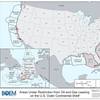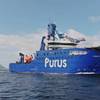Trade Increase Hides Specialized Reefer Vessels Uncertainty
Drewry’s latest Reefer Shipping Market Annual Review and Forecast reports that worldwide perishable reefer trade increased by 52.1 million metric tons between 2002 and 2012, which represents by a combined annual growth rate (CAGR) of 3.6%. Seaborne perishable reefer cargo has increased by a CAGR of 3.3% (25.6 million metric tons) from 66.8 million metric tons in 2002 to 92.4 million metric tons in 2012.
The highest percentage growth continues to be seen in the exotic fruit category (pineapples, kiwifruit and avocadoes). Despite its relatively small volume of 4.5 million metric tons in 2012, this sector has grown by a CAGR of 9.1% since 2002. In terms of tonnage, the highest growth has been in the meat category (comprising poultry, pork, beef/veal, offal and sheep meat). This grew from 22.8 million metric tons in 2002 to 36.3 million metric tons in 2012 – a CAGR of 4.8%. Seaborne trade in the meat category has grown by 8.3 million metric tons – a CAGR of 4.6%.
Kevin Harding, editor of the report, states “It is important to note that the import patterns have changed considerably during the past decade. Western Europe has declined to a 38% share of worldwide imports – although still importing 66 million metric tons of cargo in 2012. Eastern Europe’s importance has grown from an 11% share in 2002 to a 13% share in 2012 – with cargo tonnage increasing by 76% over this period.”
Despite losses for many containership operators, collectively the industry managed to return a small profit for 2012. In the specialized reefer segment, Seatrade retains its position as the largest reefer operator – but with a reduced fleet of 77 vessels, providing over 51 million cubic feet of on-deck and under-deck capacity, which is some 12.5% less than that of one year ago. Nevertheless, it still controls in excess of 20% of the world’s specialized reefer fleet capacity of vessels greater than 100,000 cubic feet.
The average age of the fleet of 600 specialized reefer ships greater than 100,000 cubic feet has increased to 24 years – despite continued heavy scrapping during the past 12 months. Star Reefers has the youngest fleet among the major operators (with an average age of 14 years), while Baltic Reefers has the oldest with an average age of 28 years.
The first half of 2013 appeared to herald the start of a long awaited upturn for the specialized reefer industry. Time charter rates improved, scrapping had shrunk the fleet to more manageable levels and the containership industry finally seemed to understand that life was not all about market share.
Kevin Harding summarized the state of the market saying; “The two modes of transport have experienced mixed fortunes. With the continued shrinking of the specialized reefer fleet it is unavoidable that increased cargo volumes, no matter how small, will have to be shipped by reefer container vessels. The market share between the two modes continues to move in favor of the containership and, with the specialized reefer orderbook remaining at zero (at least for the time being), it is inevitable that this trend will continue.
The containership mode is forecast to provide in excess of 94% of overall reefer tonnage within the next few years. However, the specialized reefer industry is focused purely on refrigerated cargoes and is able to optimize cargo carriage and voyage times – thereby providing a higher percentage of annualized cargo capacity than the figures might otherwise suggest. Thus, the statistics continue to demonstrate that cargo volumes can be accommodated over both modes of transport. Forward utilization levels for specialized reefer ships are forecast to remain stable, although total cargo metric tons carried are forecast to reduce year-on-year as the fleet shrinks.”
drewry.co.uk











